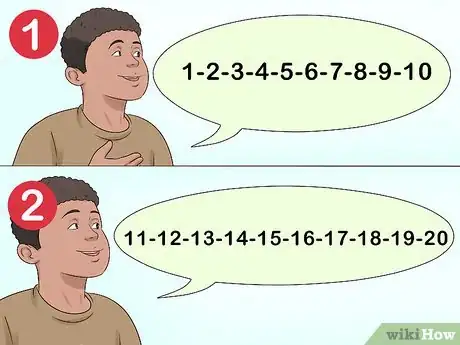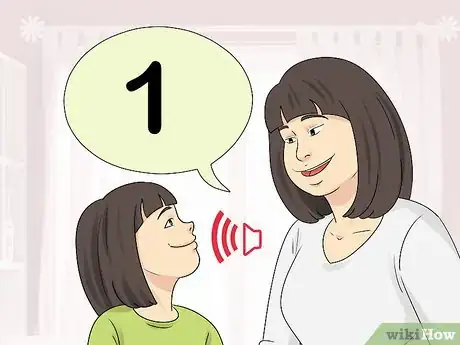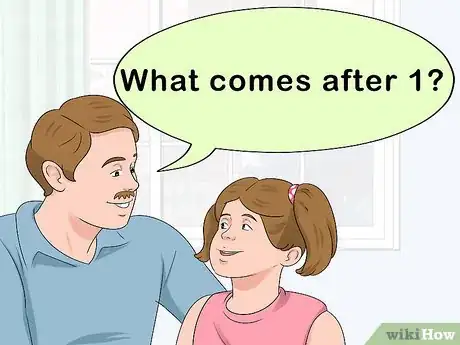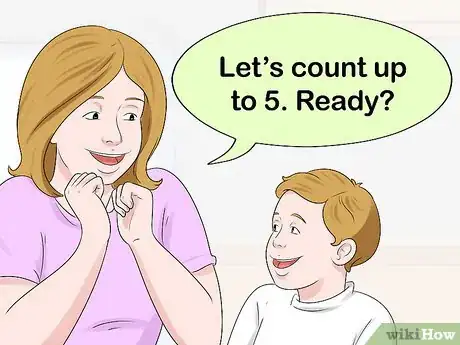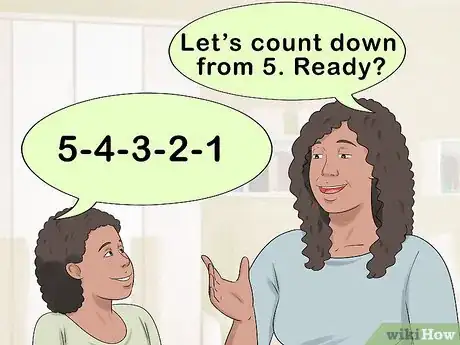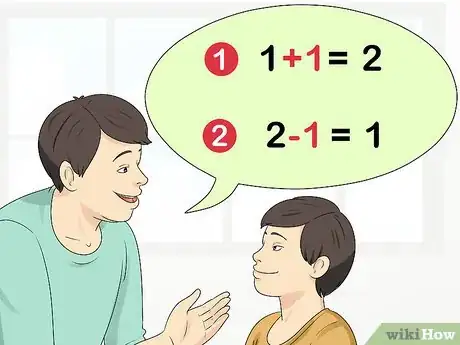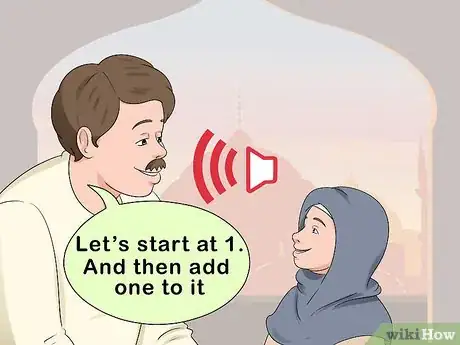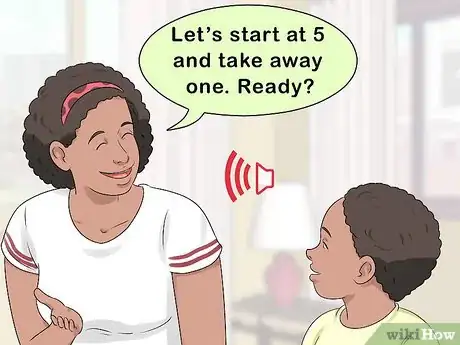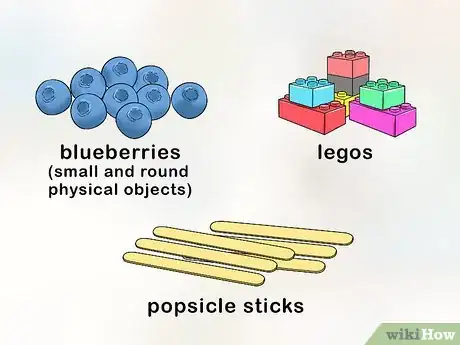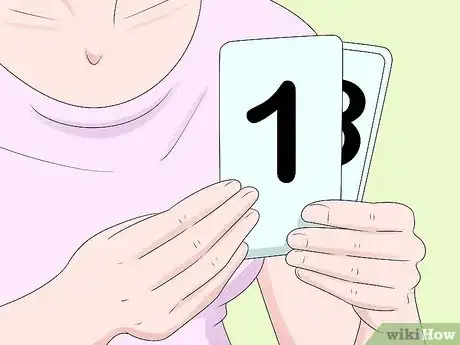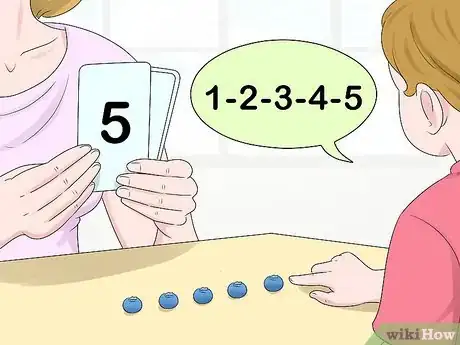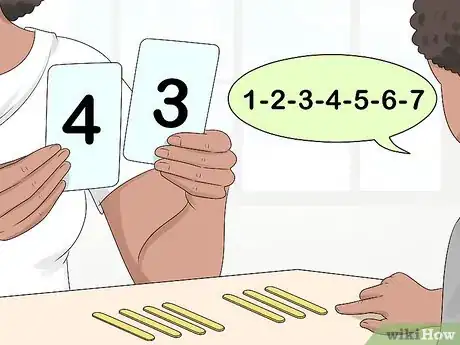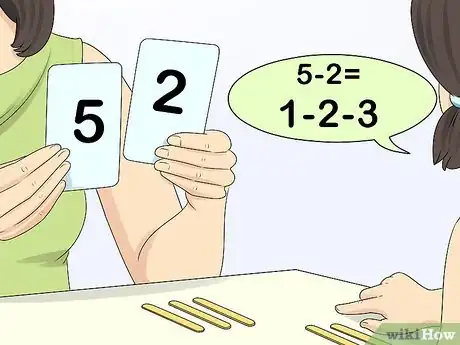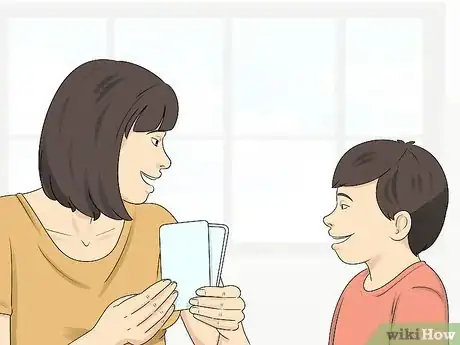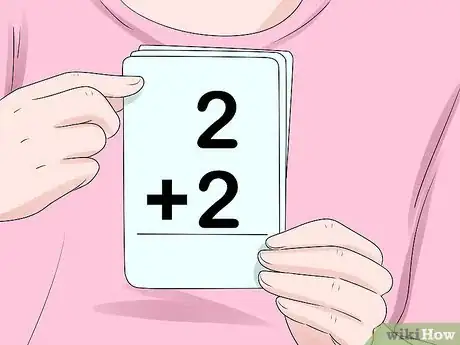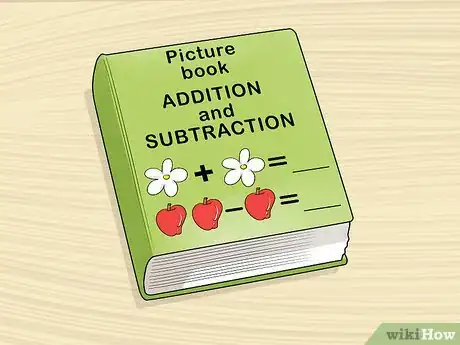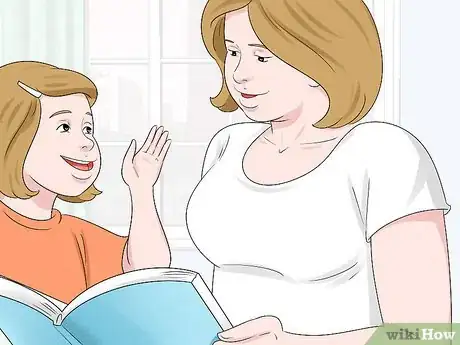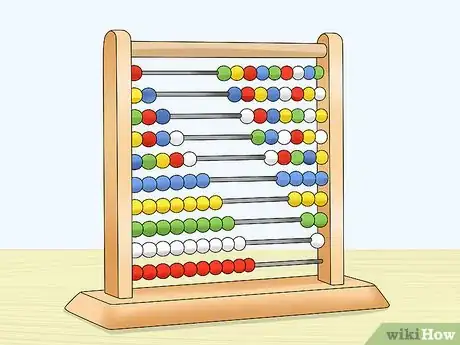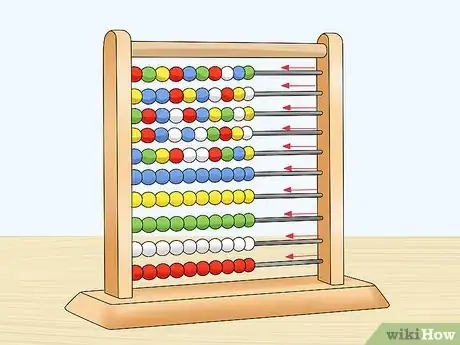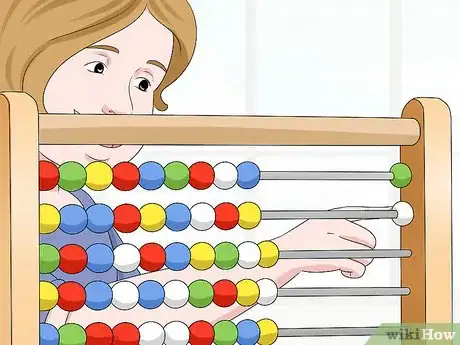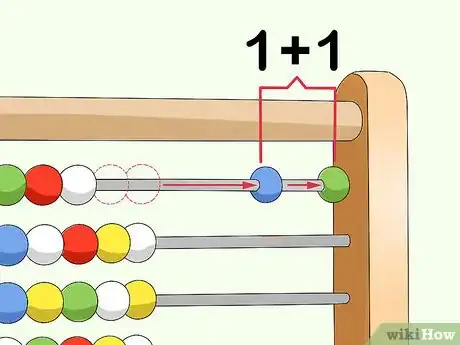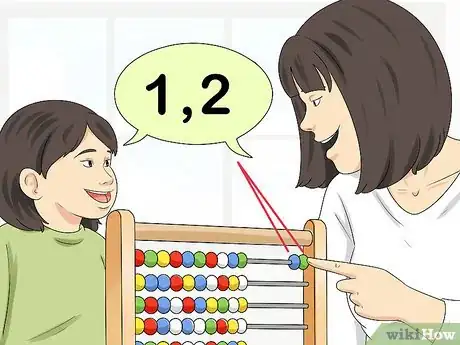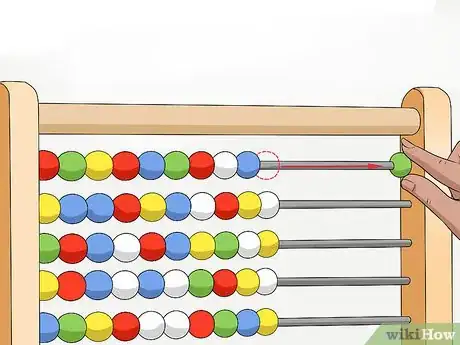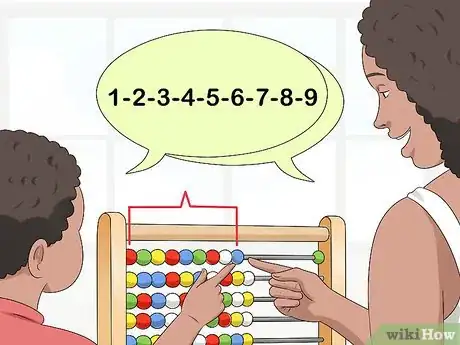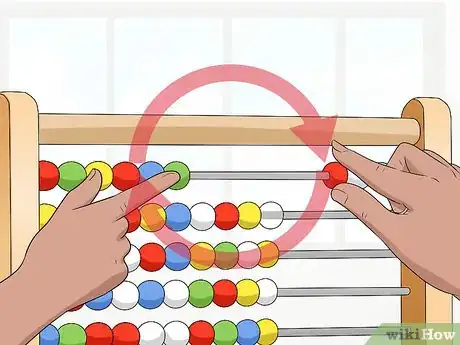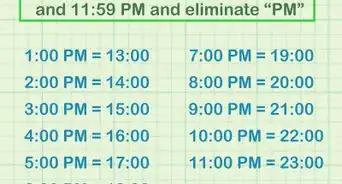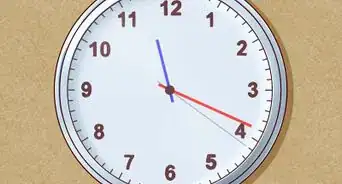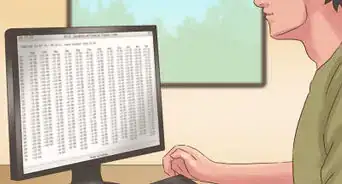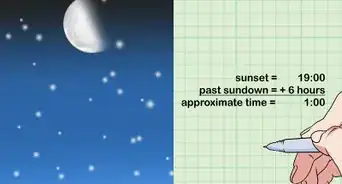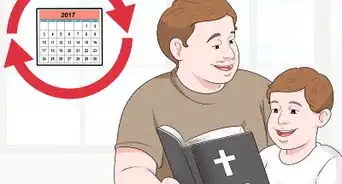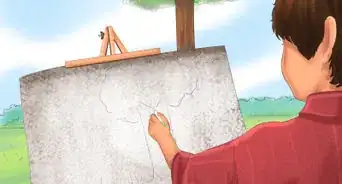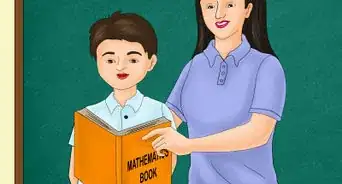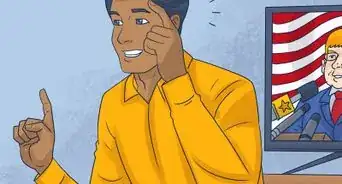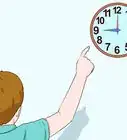This article was co-authored by Soren Rosier, PhD. Soren Rosier is a PhD candidate at Stanford's Graduate School of Education. He studies how children teach each other and how to train effective peer teachers. Before beginning his PhD, he was a middle school teacher in Oakland, California, and a researcher at SRI International. He received his undergraduate degree from Harvard University in 2010.
This article has been viewed 125,960 times.
Teaching your child how to add and subtract can be a challenge, especially if they are new to numbers and math. Luckily, there are many different ways you can use to show your child this vital skill and help them become familiar with numbers. Some children learn well by doing mental math. Others respond to counting out physical objects like raisins, blueberries, or legos or by using picture books. If your child is a visual learner, you can also use an abacus to teach them how to add and subtract. However your child learns, try to use multiple methods to keep them engaged and having fun.
Steps
Teaching Mental Math
-
1Have them recite 1-10, and then 10-20. Start by saying “1” and then have your child repeat after you. Count up to 10 together. Do this at least two times so your child can get used to hearing the numbers out loud. This will also help them learn the ordering of the numbers.
- You can then move on to saying “10” and having your child repeat after to you. Count up to 20 together. Do this at least two times.
- Draw a number line to help your child understand the relationship between each number.[1]
-
2Say “1” out loud to your child. Once your child is comfortable with saying the numbers aloud, you can start to teach them how to add and subtract. Say “1” in a clear voice to your child.Advertisement
-
3Have them respond with the next number. Ask them, “What comes after 1?” Wait five to ten seconds for them to respond. Allow them time to think about their answer.
- If they do not seem to know the answer, you may say, “2.” You can then go through all the numbers again, counting aloud together. Then, try asking them “What comes after 1?” again. Work with them until they remember the right answer and respond with “2.”
- You can also take turns saying one number. For example, you may say “2” and your child may say “3,” you may say “4” and your child may say “5.”
-
4Encourage them to count up to a number. You may say, “Let’s count up to 5. Ready?” Then, encourage your child to count aloud to 5. Give them time to think and do not rush them. You can prompt or encourage them as needed.
- When they get to 5, congratulate them and say “Great going” or “You got it.”
-
5Have them count down to a number. You may say, “Let’s count down from 5. Ready?” Then, encourage them to count down to 1. Remind them that you are going backwards, down from 5 to 1, rather than up, from 1 to 5.
-
6Explain what addition and subtraction are. Tell your child, "When we put more onto a number, we are adding to it." You can then use an example like adding one to "1" to make "2." Compare it to counting up to a number, where you add onto the original number to get a higher number.
- You can then explain subtraction by telling your child, "When we take away from a number, we are subtracting from it." Use an example like removing one from "2." Compare it to counting down to a number, where you subtract from the original number to get a lower number.
-
7Instruct them to add out loud. You may say, “Let’s start at 1. And then add one to it. We’ll count together. Ready?” Then, encourage your child to start at 1 and add one to get to 2. Give them time to count aloud to 2. If they get stumped, helped them along.
- You can also try having them start at 1 and adding two to get to 3. Then, have them try counting from 2 and adding two to get 4.
- Work with them on adding small amounts of one, two, and three. Make sure they speak aloud when they are counting so they can do the math in their head.
- Discourage them from counting on their fingers. Try to get your child to count in their head instead.
-
8Encourage them to subtract out loud. You may say, “Let’s start at 5 and take away one. Ready?” Then, give them time to get to 4. Remind them of the number that is one below 5 to help them subtract correctly.
- You can then encourage them to subtract two from 5 or two from 3. Make sure they say the numbers out loud as they subtract.
-
9Do mental math once a day with your child. The more you do mental math with your child, the better they will get. Set aside one hour a day to do mental math with them. Work on teaching them how to add or subtract larger amounts. Make sure you both say the numbers aloud so they can learn to do the math in their head and memorize the numbers by listening to them.
Using Physical Objects and Flashcards
-
1Choose small, round physical objects like blueberries, legos, or popsicle sticks. It may be helpful to connect math with the child's experience and make it more visual.[2] Pick objects that are the same and easy for your child to pick up and hold. A food like blueberries or Cheerios may be good, especially if you want to give them to your child as a snack later. Popsicle sticks, legos, or wooden blocks would also work.[3] Generally, try to use something you have a lot of.[4]
- Avoid sharp objects or objects with sharp corners. Do not use objects that are different shapes or colors, as this can confuse your child.
- Bouncy balls, rubber insects, and puff balls also work well for this.[5]
-
2Use flashcards with numbers as a guide. You can write the numbers 1-10 on flashcards or use math flashcards with numbers printed on them. You can also use a deck of UNO cards as long as they only have one number on them.[6]
- Make sure the numbers are clearly printed, large, and easy for your child to see.
-
3Have your child count out the objects to a number on the flashcard. Put the objects in a pile. Then, flip over a flashcard with a number on it. Have your child count out the same number of objects from the pile. You may count with them at first to help them get the hang of the numbers.[7]
- For example, if you flip over a flashcard that says “5,” you may then instruct your child to count out five of the objects.
- Keep doing this with different flashcards. Have your child count the objects out several times to different numbers so they get a hang of the math.
-
4Instruct them to add to the pile using the flashcards. Put out one flashcard and encourage them to count out the objects to the first number in a pile. Then, pull out a second flashcard and tell them, “Now, how much would we have if we add this amount?” Have them add the corresponding number of objects to the pile.[8]
- For example, if you put out a flashcard that says “3,” you would first instruct your child to count out three objects. Then, if you pull out a flashcard that says “2,” have them add two more objects to the three objects. Finish by counting out the total number of objects in the pile together so it equals “5.”
-
5Ask them to subtract objects from the pile. Once they get the hang of adding to the pile of objects, have them remove objects to learn how to subtract.[9] Show them the number on first flashcard and have them count out the objects. Then, show them another flashcard and say, “Now, what we would we get if we take away this number from the pile?” Give them time to subtract the right amount from the pile.[10]
- For example, if you pull out a flashcard that says “5,” have your child count out five objects. Then, if you pull out a flashcard that says “2,” have your child remove two objects from the five objects. Finish by counting out the total number of objects in the pile together so it equals “3.”
-
6Practice addition and subtraction with the objects once a day. Get in the habit of doing one hour of addition and subtraction with your child using the objects and the flashcards. Work up to adding and subtracting larger numbers with the objects.[11]
-
7Use new flashcards with additions on them. Put additions like "1 + 1" or "2 + 2" on the flashcards. Then, use the addition cards and the objects with your child to take their skills to the next level. Have them show you how to add 1 to 1 or 2 to 2 using the objects.
- You can then add in flashcards that have more complicated additions or subtractions, such as "3 + 2" or "5 - 2."
-
8Use different objects and games to make it more fun for your kid. Once your kid gets the hang of it, switch up the objects you're using so they don't get bored. Also, turn it into a game you can both play, like seeing who has the larger sum. Varying the activity every time will make it more engaging for your kid.
Using Picture Books
-
1Look for picture books that focus on addition and subtraction. Picture books are a great option if your child is a visual learner and has a hard time doing mental math. You can find picture books for children that break down math concepts like addition and subtraction at your local library or online. The picture books may use animals or interesting characters to demonstrate math concepts.
- You may need to look in the children's section or the non-fiction section of your local library to find picture books on math for children.
-
2Get a picture book that suits your child's age and learning level. Look for a picture book that is made for your child's age group, such as 0-2 years old or 2-5 years old. Some picture books will also be labeled by grade level, such as kindergarten or grade 1.[12]
- You can also get a picture book that has an engaging plot that weaves math into the story if your child is older and can follow along with a plot.
- You may get a picture book that uses bold visuals so your child stays engaged in the content.
-
3Work through the picture book with your child. Sit down with your child and look through the picture book together. Encourage them to talk to you about the numbers, as well as the addition and subtraction in the book.[13]
- Some picture books will require reader participation, such as counting the objects in the images or answering questions about addition or subtraction. Encourage your child to respond to the book and interact with it so they can follow along and learn.
Teaching with an Abacus
-
1Get an abacus at your local toy store or online. An abacus is a counting tool consisting ten rods on a wooden frame and 100 colored beads. The beads are divided into rows of ten of the same color.[14]
- Look for an abacus that has brightly colored beads, as this is usually more visually stimulating for children. The beads should consist of five rows of different colors, followed by five rows of the same colors in a different pattern.
- Get an abacus with larger beads, as they are easier for kids to move.
-
2Push all the beads to the same side. Place the abacus on a table in front of your child. Then, move all the beads on the abacus to the same side on every row. This will make it easier for your child to watch you as you move and count the beads aloud.[15]
-
3Move one of the beads on the top row. Show your child the abacus so they can see you moved one bead.[16]
-
4Have your child match your beads. Ask your child to then move one of the beads on the bottom row of the abacus. Say “1” together as they move the bead so they understand that this is one bead.[17]
-
5Repeat this with a different amount of beads. Move two beads on the top row and ask your child to match your move, moving two beads on the bottom row. Continue doing this until you reach “10.” Make sure your child says the numbers aloud as they move their beads.[18]
- At “10,” all the beads on your row and all the beads on your child’s row should be moved to the other side of the abacus.
-
6Add beads from one side to the other side of the abacus. Push all the beads on a row to one side of the abacus. Then, move one bead to the other side of the abacus and add one bead.[19]
-
7Count the beads you have moved aloud with your child. Point to the beads you have moved and say “1, 2” together with your child.[20]
- You can then push another bead to the other side and count the beads again. Point to both beads and say “1, 2, 3” with your child.
- Continue doing this, adding one bead at a time to the other side of the abacus. Work with your child to get to “10.”
-
8Subtract beads from one side to the other side. Make sure all the beads are on one side of the abacus. Then, push one bead to the other side.[21]
-
9Count the remaining beads with your child. Ask your child to count the remaining beads on the side of the abacus. Say “1, 2, 3, 4, 5, 6, 7, 8, 9” together. Point to the beads as you count them.[22]
- You can then continue to subtract beads from one side and count the remaining beads together. Do this until you reach one bead remaining and then no beads remaining on one side of the abacus.
-
10Continue practicing addition and subtraction with the abacus. Trying adding two beads at a time to one side of the abacus and counting them out. Or, subtract two beads at a time and count out the remaining beads with your child. Work with your child slowly so they can learn how to add and subtract small amounts, followed by larger amounts.[23]
Expert Q&A
-
QuestionHow do I teach my first grader to add and subtract?
 Courtney CoprivizaCourtney Copriviza is an Elementary School Teacher based in Maui, HI. Courtney specializes in elementary education, classroom management, and social and emotional development. She holds a BA in Communication with a minor in Urban Education and an MA in Teaching from Santa Clara University. Courtney has also taught high school in Madrid, Spain. She is a member of Kappa Delta Pi International Honors Society in Education.
Courtney CoprivizaCourtney Copriviza is an Elementary School Teacher based in Maui, HI. Courtney specializes in elementary education, classroom management, and social and emotional development. She holds a BA in Communication with a minor in Urban Education and an MA in Teaching from Santa Clara University. Courtney has also taught high school in Madrid, Spain. She is a member of Kappa Delta Pi International Honors Society in Education.
Elementary School Teacher Start teaching addition and subtraction with items the student can touch, like rubber insects, bouncy balls, puff balls, or any other item that you have plenty of. You could invite the child to grab 4 rubber ants from 1 container, and then grabbing another 5 so they have 9. Or, you could give the child 15 bouncy balls and ask them to put 7 back into the container.
Start teaching addition and subtraction with items the student can touch, like rubber insects, bouncy balls, puff balls, or any other item that you have plenty of. You could invite the child to grab 4 rubber ants from 1 container, and then grabbing another 5 so they have 9. Or, you could give the child 15 bouncy balls and ask them to put 7 back into the container. -
QuestionWhat is a fun way to teach addition and subtraction?
 Courtney CoprivizaCourtney Copriviza is an Elementary School Teacher based in Maui, HI. Courtney specializes in elementary education, classroom management, and social and emotional development. She holds a BA in Communication with a minor in Urban Education and an MA in Teaching from Santa Clara University. Courtney has also taught high school in Madrid, Spain. She is a member of Kappa Delta Pi International Honors Society in Education.
Courtney CoprivizaCourtney Copriviza is an Elementary School Teacher based in Maui, HI. Courtney specializes in elementary education, classroom management, and social and emotional development. She holds a BA in Communication with a minor in Urban Education and an MA in Teaching from Santa Clara University. Courtney has also taught high school in Madrid, Spain. She is a member of Kappa Delta Pi International Honors Society in Education.
Elementary School Teacher Invite your students to use visuals. For instance, if they're solving a problem like 6 + 4, they could draw 6 blue circles and 4 red circles to visualize the problem. Then, then could count all the circles together and write down their answer.
Invite your students to use visuals. For instance, if they're solving a problem like 6 + 4, they could draw 6 blue circles and 4 red circles to visualize the problem. Then, then could count all the circles together and write down their answer. -
QuestionHow do you teach addition on a number line?
 Courtney CoprivizaCourtney Copriviza is an Elementary School Teacher based in Maui, HI. Courtney specializes in elementary education, classroom management, and social and emotional development. She holds a BA in Communication with a minor in Urban Education and an MA in Teaching from Santa Clara University. Courtney has also taught high school in Madrid, Spain. She is a member of Kappa Delta Pi International Honors Society in Education.
Courtney CoprivizaCourtney Copriviza is an Elementary School Teacher based in Maui, HI. Courtney specializes in elementary education, classroom management, and social and emotional development. She holds a BA in Communication with a minor in Urban Education and an MA in Teaching from Santa Clara University. Courtney has also taught high school in Madrid, Spain. She is a member of Kappa Delta Pi International Honors Society in Education.
Elementary School Teacher A number line helps students understand the relationship between different numbers. Let's say you have a number line going from 0 to 20. Invite your student to start at 6, and then "jump" 4 more spaces, which brings them to 10. Encourage them to count in their head as jump to the next number—this helps get them more comfortable with mental math.
A number line helps students understand the relationship between different numbers. Let's say you have a number line going from 0 to 20. Invite your student to start at 6, and then "jump" 4 more spaces, which brings them to 10. Encourage them to count in their head as jump to the next number—this helps get them more comfortable with mental math.
References
- ↑ Courtney Copriviza. Elementary School Teacher. Expert Interview. 18 June 2021.
- ↑ Soren Rosier, PhD. PhD in Education Candidate, Stanford University. Expert Interview. 1 May 2019.
- ↑ https://brightside.me/inspiration-family-and-kids/13-interesting-ways-to-teach-your-child-addition-and-subtraction-193955/
- ↑ Courtney Copriviza. Elementary School Teacher. Expert Interview. 18 June 2021.
- ↑ Courtney Copriviza. Elementary School Teacher. Expert Interview. 18 June 2021.
- ↑ http://stayathomeeducator.com/introducing-your-preschooler-to-addition-and-subtraction/
- ↑ http://stayathomeeducator.com/introducing-your-preschooler-to-addition-and-subtraction/
- ↑ http://stayathomeeducator.com/introducing-your-preschooler-to-addition-and-subtraction/
- ↑ Courtney Copriviza. Elementary School Teacher. Expert Interview. 18 June 2021.
- ↑ http://stayathomeeducator.com/introducing-your-preschooler-to-addition-and-subtraction/
- ↑ http://stayathomeeducator.com/introducing-your-preschooler-to-addition-and-subtraction/
- ↑ http://www.carolhurst.com/subjects/math/computation.html
- ↑ http://www.carolhurst.com/subjects/math/computation.html
- ↑ https://wehavekids.com/education/How-to-teach-Abacus-to-kids
- ↑ https://wehavekids.com/education/How-to-teach-Abacus-to-kids
- ↑ https://wehavekids.com/education/How-to-teach-Abacus-to-kids
- ↑ https://wehavekids.com/education/How-to-teach-Abacus-to-kids
- ↑ https://wehavekids.com/education/How-to-teach-Abacus-to-kids
- ↑ https://wehavekids.com/education/How-to-teach-Abacus-to-kids
- ↑ https://wehavekids.com/education/How-to-teach-Abacus-to-kids
- ↑ https://wehavekids.com/education/How-to-teach-Abacus-to-kids
- ↑ https://wehavekids.com/education/How-to-teach-Abacus-to-kids
- ↑ https://wehavekids.com/education/How-to-teach-Abacus-to-kids
About This Article
If you set your kid up with a good basis of mental math, it’ll be much easier to teach them adding and subtracting. To start, help them memorize the numbers 1-10. Then, 10-20. Once they feel familiar with these numbers, explain what addition and subtraction are. You could say, “When we put more onto a number, we’re adding, and when we take away some, we’re subtracting.” Give them examples, starting with adding or subtracting 1, then moving onto higher numbers. To practice, you can demonstrate with food like blueberries or Cheerios or objects like legos or popsicle sticks. Once your kid gets the hang of it, switch up the objects and try using bigger numbers to keep it fun and interesting. If you encourage them and help them practice each day, eventually they’ll master it. To learn how to use picture books to help your kid learn math, read more from our Education co-author.
